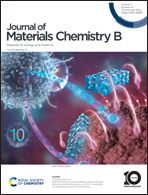A multifunctional bio-patch crosslinked with glutaraldehyde for enhanced mechanical performance, anti-coagulation properties, and anti-calcification properties
Abstract
Bio-patches for the treatment of valvular disease have been evaluated in clinical trials. It has been shown that failure of these devices, occurring within a few years of implantation, may be due to cytotoxicity, immune response, calcification and thrombosis. Some of these effects may be due to the glutaraldehyde crosslinking process used in the preparation of the materials. A number of studies have focused on strategies to control calcification, while others have concentrated on the prevention of micro-thrombus formation. In the present work, we have introduced amino-terminated poly(ethylene glycol) (NH2–PEG–NH2) as an intermolecular bridge, which not only eliminates free aldehyde groups to prevent calcification, but also introduces sites for the attachment of anticoagulant molecules. Furthermore, PEG, itself a hydrophilic polymer with good biocompatibility, may effectively prevent protein adsorption in the early stages of blood contact leading to thrombus formation. After further covalent attachment of heparin, modified bovine pericardium (BP) showed strong anti-calcification (calcium content: 39.3 ± 3.1 μg mg−1) and anti-coagulation properties (partial thromboplastin time: >300 s). The biocompatibility and mechanical properties, important for clinical use, were also improved by modification. The strategy used in this work includes new ideas and technologies for the improvement of valve products used in the clinic.



 Please wait while we load your content...
Please wait while we load your content...